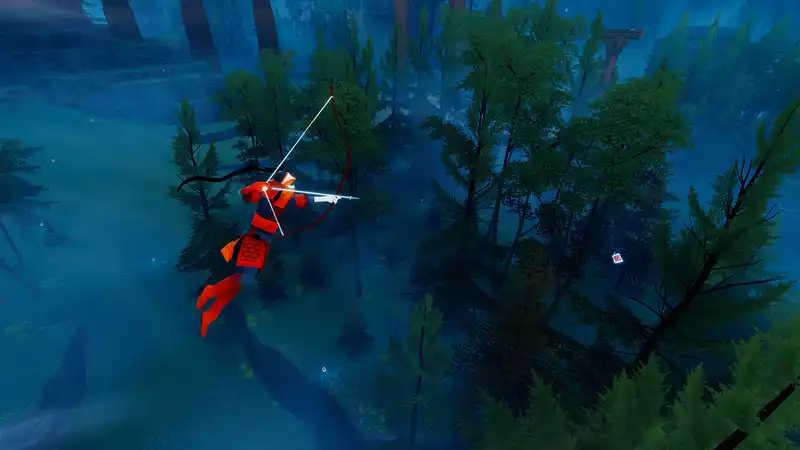The Pathless is notable for everything it doesn't have. It is an open-world game with no minimap, no fast travel, no player death, no enemies other than bosses, no NPCs, and no vehicles. Nevertheless, what the game does have is very cleverly crafted and the result is stunning.
The story's roots are well known, a fantastical land overrun by an evil curse, and you're supposed to become a heroic mop to clean up the mess, but don't be fooled. That becomes clear the moment you dash across the field: your sprint is driven by a rapidly depleting meter, but can always be replenished by shooting floating talismans.
There is no need to manually aim the Talisman, at least not in the traditional sense. If you get close enough to the target or point the camera at it, it will automatically highlight it, and all you need to do is hold the button down for a second and release it. Speeding up and moving on foot is like an extended (but actually fun) QTE, where you shoot at carefully timed shots to avoid running out of meter as you hurry to your destination. Just moving from one place to another is a mild challenge and pleasure.
Hunters have a special power called "psychic vision. This is first introduced as a way to get through a clearly marked wall, but the genius of the idea is highlighted when one begins to think about what to do and where to go. There is no map, no signposts. When you do a psychic reading, everything turns a beautiful blue color and places of interest flash red. Whether it's one of the items needed to advance the story or an area where an optional collectible is hidden, we often don't know exactly what's there, but we can guarantee that it's something worth finding.
The idea of a detective mode, as in "Arkham," is now widely understood, but is usually used to show the player exactly what is needed, often following a linear path. In this game, the player, not the developer, chooses when and how to use it, and when approaching a place of interest, the pulses that indicate this disappear. The balance between player freedom and developer support is excellent.
In this world, instead of enemies, there are puzzles, and I enjoyed them all; I never got stuck for more than a minute, and even that was rare. This is not to say that the puzzles are too easy, but rather a sign that the game is always focused on smooth movement.
In these puzzles, the eagle and the bow tend to play equally important roles. For example, you need to shoot a series of arrows at a target, but you need the eagle Keith (not his name, but let's call him that for the sake of argument) to help you line them all up. Keith would need to move the target, lift weights and carry them to the pressure plate. He can only carry one thing at a time, so he cannot lift you into the air while he already has something in his talons. So when I found the weight on the ground and the pressure plate about 100 feet in the air, I had to twist my head a bit.
Aside from puzzles, I enjoy finding thoughts of dead soldiers frozen in time, or gazing at abandoned temples, mysterious structures, and the skeletons of giant unknown beasts. Sometimes, I soar through the sky, hanging on to the legs of a surprisingly strong eagle, as I drift gently to my next destination and take in the best views.
I have two criticisms: first, area bosses sometimes trigger events that cause the eagle to get separated from the eagle before it is ready to face the boss. We have to slowly creep up to rescue the eagle and stop periodically each time the big bad guy's eyes are on us. This gets tiresome after a few times. Second, once the bird is retrieved, it needs to be cleansed with stroking motions all over its body until the cursed juices are gone. I understand that this is to strengthen the bond, but this also gets frustrating after a while. Also, one of the boss fights dragged on a bit too long, as I had trouble hitting multiple weak spots in a row. Ok, I get it.
I just can't get over my anger at this game. The main motivation for the villain's misdeeds is the desire to provide a rigorous path for all to follow in life, which seems to be a comment on the Giant Squid's approach to designing the game as a whole. While the bosses follow a fairly strict pattern of a chase to exploit a weakness, an arena fight to exploit a weakness, and one or two final stages to exploit a weakness, the majority of the game does not. Boss fights are "unlocked" by collecting and using certain items, but each area of the map has more items than are actually needed. The items to collect and the order in which they are collected can be determined by your curiosity. In case you get stumped by a puzzle, there is another one to solve within a few minutes.
The storyline comes to a satisfying conclusion, and I happily dive back in to clean up the remaining puzzles.
.

Comments